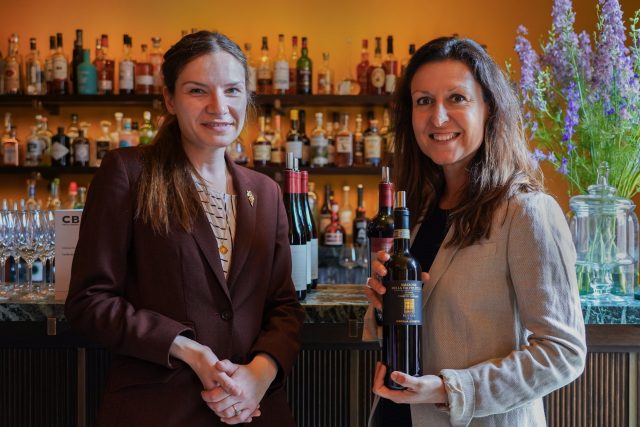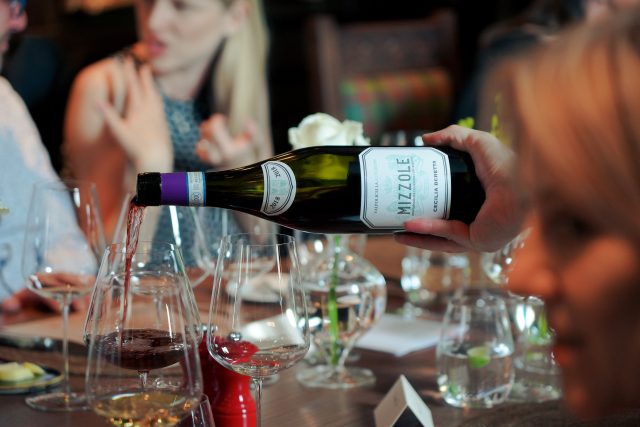This website uses cookies so that we can provide you with the best user experience possible. Cookie information is stored in your browser and performs functions such as recognising you when you return to our website and helping our team to understand which sections of the website you find most interesting and useful.
Exploring the pairing potential of Cecilia Beretta
This week’s London tasting of Pasqua’s Cecilia Beretta range demonstrated how to use food pairings get the most out of these premium wines from Veneto.

The tasting, held at Mount St. Restaurant and Rooms, saw cousins Riccardo and Cecilia Pasqua present the range for the first time in London, with pairings as curated by the venue’s head of wine Agnieszka Swiecka.
Swiecka won the 2023 IWSC Emerging Talent in Hospitality, a prize sponsored by Pasqua Wines.
Explaining the history of the range, company CEO Riccardo Pasqua said: “Cecilia Beretta has been in the Pasqua family since 1989, and it was built on strong female talent…It is the most elegant and classic expression of Pasqua.”
Cecilia Beretta the person was the daughter of Count Giuseppe Beretta, who served as mayor of Verona in the 17th century.
The winery was founded as a viticultural research centre in her honour in the 1980s. Today, Cecilia Beretta is Pasqua’s most prestigious estate, and is driven by two women – Cecilia Pasqua, who looks after export, marketing and operations, and oenologist Graziana Grassini, a figure who has been something of a pioneer for female winemakers in Italy and began her collaboration with Pasqua in 2018.
The grapes, sourced from Valpolicella and Soave, are used to make a number of expressions for the Cecilia Beretta range, including a rosé, as well as more classic styles from the region.
Though the full range was sampled, three labels were selected for the lunch.
Starter
First up was the Brognoligo Soave Classico DOC 2021.
As it was poured to the assembled guests, Cecilia Pasqua said: “We are aiming to give a sense of place to our wines, so most of them are single vineyards…This area [Brognoligo, to the east of Verona] is grown on volcanic soil, which gives a lot of minerals to the wine.” (To read more about the importance of soil to Soave soils, click here.)
The shoots of the Garganega vines (the wine is single varietal) are cut 15 days before the harvest in order to, as Cecilia Pasqua put it, give “a little bit of appassimento”.
Swiecka said that there are “two ways” to go about pairing with this Soave Classico: “I always find that the gentle, ripe fruitiness in Soave balances white crab meat very well. But is also easy to balance its slight vegetal bitterness and almond finish with asparagus.”
Plumping for the former, it was indeed a very good match, with the wine’s acidity also slicing through the intense brown crab meat mayonnaise served alongside the white meat.
Main
After this, the Mizzole Valpolicella DOC Superiore 2018 was served alongside the chop (served rare), belly and sweetbread of a West Country lamb, accompanied by mint jelly and a hispi cabbage roll.
A blend of 60% Corvina, 25% Corvinone, 10% Rondinella and 5% Oseleta, the fruit for Mizzole was sourced from the calcareous and caly-soiled vineyard of the same name, a plot that has been owned by Pasqua for 40 years.
Describing the wine’s profile, Riccardo Pasqua said he sought “verticality, not horizontality” from it, meaning that he wanted it to taste of its place of origin.
In keeping with this philosophy, Grassini aged 55% of the wine in barriques and tonneaux (30% new oak) for nine months in order to allow the terroir to shine through.

“We eat lamb throughout different seasons – it’s not always rich and earthy,” said Swiecka, who revealed that Mizzole is her favourite wine in the Cecilia Beretta range. “Here, we serve it with fresh ingredients, like mint jelly – the wine still has enough tannic structure to go with the meat, but also a touch of green herbs to complement the green herbs in the dish.”
For the pescatarian option of cod, the Mizzole was also prescribed due to its acidity working well with the firm, fleshy white fish.
The surprise addition of bowls of freshly-fried chips also put this freshness to the test, and while not a perfect pairing, it certainly passed.
Dessert
To cap the meal off, a selection of British cheeses, including blue, brie-esque and Cheddar-adjacent examples, were served.
Terre di Cariano Amarone della Valpolicella DOCG Classico Riserva served as a good fit, with the appassimento drying of the grapes over three months lending the sort of intensely fruity quality that a chutney, or a Port, might have brought. There is a symbiosis – the creaminess of the cheese softens the wine, and the wine lifts the cheese.
Two years were selected, 2015 and 2012, described by Cecilia Pasqua as “two of the best vintages of the decade”.
Riccardo Pasqua told db: “I think Pasqua has been a pioneer of the new style of Amarone.”
“In 2016, with the Mai Dire Mai [‘Never Say Never’] project we were one of the first to come out with an Amarone that was as sharp as a knife, with just 2 grams of residual sugar.”
By contrast, Terre di Cariano 2015 posseses 8.9g/l of residual sugar. Though less heavily-structured than some other Amarones, it has plenty of ageing potential, as the freshness of the 11-year-old bottle tasted demonstrated.
On this subject, Riccardo Pasqua remarked: “What we sometimes lack in Italy is longevity – we need to be more patient and keep our wines for a bit longer!”
Food for thought
When asked about what the consumer base is for the range, Riccardo Pasqua opined: “Cecilia Beretta is a fairly small azienda agricola, producing a little north of 200,000 bottles. Lack of availability channels us to sell it in top restaurants and wine bars – therefore you have a natural selection that pushes the average customer age up. These are classic wines, but with agility, making them good for gastronomy – it’s a category with more mature, experienced drinkers.”
Interestingly, the menu had little to no Italian influence whatsoever, instead being British produce prepare in a largely classical French manner.
The pairing possibilities of Italian wines, especially white wines from Northern Italy, with non-Italian dishes, particularly from Japanese and other East Asian cuisines, has been the subject of several key promotional pushes from various producers and consorzi, including Bisol 1542, Lugana DOC, and Soave.

